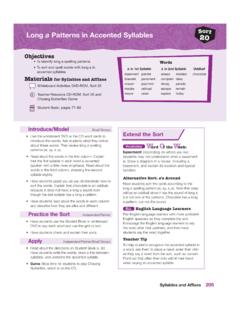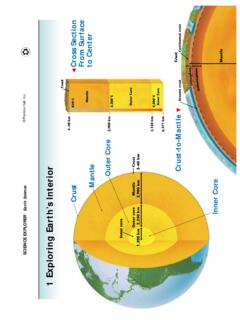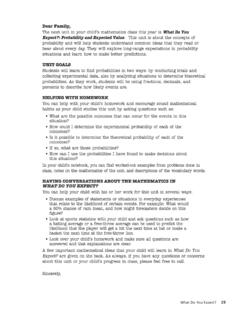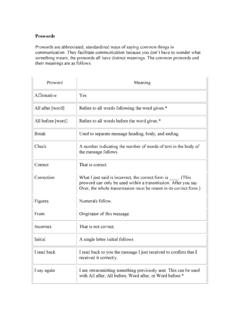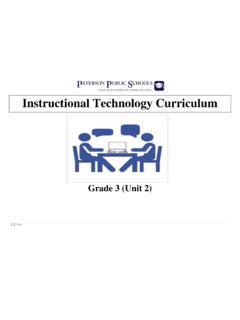Transcription of Within Word Pattern - Prentice Hall
1 Within Word PatternThe Within Word Pattern stage of literacy development is a transitional period a time between the beginning stage, when students reading and writing are quite labored, and the intermediate stage, when students can read nearly all texts they encounter. During the Within Word Pattern stage, students begin to decode and store words more readily, and their sight word vocabulary grows quickly. This enables them to read and write with increasing fluency and expression. Students in this stage become wordsmiths, collecting hundreds of of Sorts in Within Word PatternyyShort and Long VowelsyyOther Long Vowel Patternsyyr-Influenced VowelsyyDiphthongs and Other Ambiguous VowelsyyComplex Consonant ClustersyyHomophonesCharacteristics of Within Word Pattern LearnersWithin Word Pattern learners are mostly in late first, second, third, and early fourth grade.
2 Within Word Pattern Learnersyyspell most single-syllable, short vowel words most beginning consonant digraphs and two-letter consonant silently and with more fluency and expression. yycan identify most one-syllable words in context but may still struggle to spell words correctly when they more fluently and express their idea with greater sophistication. yycan revise and edit. Focus of InstructionyyTo begin this level, students review short vowels and compare them to long vowel sounds first in pictures and then in common and less common then focus on r-influenced vowels, vowel diphthongs, vowel digraph oo, and other ambiguous vowel patterns that reflect a range of vowel sounds that are neither short nor long. yyNext, students examine complex consonant clusters, including silent consonants and other consonant patterns that are influenced by vowel sounds.
3 YyStudents expand their knowledge of consonant clusters to include more difficult three-letter digraphs and , students review long a and long i vowel patterns through the study of homophones, which also provides opportunities to focus on the meanings of Tips yyFor lessons with different vowel sounds and patterns , you might have students sort by sound first. Then they can sort by students use dictionaries to look up the meanings of homophones. Then encourage them to show their understanding of the meanings through pictures or context Within Word 1328/4/11 3:49 PMWithin Word PatternPace of InstructionNot all students learn and work at the same pace. Therefore, to meet students needs, make adjustments to the pace of instruction.
4 Through careful observation and assessment, you can decide when and where you can go faster or may need to go slower. The spell Checks can help you determine the focus and pace of instruction. For students who catch on quickly, increase the pace by spending less time on some sorts or by skipping some sorts entirely. Conversely, for those students who are not on track for meeting end-of-year goals, spend more time on instruction and provide more practice by creating additional sorts. If students are in the early part of this stage, there is a greater sense of urgency to catch them up with their peers. Modifying the pace and using flexible small groups allows you to avoid teaching students what they already know and to spend more time on features that need instruction.
5 Use the spell Checks as pretests to determine instructional Study RoutinesShared Reading The Big Book of Rhymes provides a way to introduce the sort in a meaningful context and provides poems that focus on the features for word study. Here are steps for sharing the the title and discuss the illustration with the poem to students, inviting them to read along with you. yyDiscuss the feature being studied that week. yyRead the poem again. Ask students to identify words with the targeted feature. For example, This rhyme has several words with the short o sound. Here is the word clock. Can you find other words with the short o sound?Introduce the Sort There are several options for introducing the sort. Here are the basic steps for a teacher-directed sort.
6 YySay Let s read over these words (name these pictures) to be sure everyone knows how to read them (name them) and what they mean. Take time to discuss the meaning of any pictures or words that may be unfamiliar. yyIntroduce the target sounds and/or patterns that serve as category headers for the sorting columns. Identify the key picture and/or word for each feature. yyExplicitly identify the features that students will look for as they sort. We are going to sort by short and long a sounds. We will sort the words into categories of words with short a, words with long a spelled ai as in rain, and words with long a spelled a plus e as in face. yyModel how to sort. This is the word dash. It has a short a sound. I will put it in this column under the word cat.
7 YyContinue demonstrating how to sort one or two words for each feature, describing why each word goes in the specific category. Help students complete the sort. yyAt this point, you may want to discuss oddballs. Oddballs are words that do not fit the targeted spelling Pattern . Help students identify an oddball and explain why it is an oddball. This word is said. It has ai in its spelling, but it does not make the long a vowel sound. Said is an oddball because it doesn't fit the how to check the sort by reading down each column to listen for the sound or to look for the Pattern . Discuss how all the words in each category are Have students sort the words individually or with partners. Encourage them to explain their sorting categories.
8 Help students check by reading down columns for consistency of sounds or patterns . Help students identify a misplaced word and place it in the correct Word Pattern 1338/4/11 2:48 PMWithin Word Pattern Library The library is comprised of little books that correspond to each of the sorts in the Within Word Pattern these little books as you would any little books: for picture walks, for choral reading, for echo reading, or for independent completing a sort, read the book with students. Have them look for words in context that have the features being studied. yyRecord words on a chart or have students write them in their word study Tip Students do not automatically see the relationship between spelling words and reading words .
9 In word hunts, students hunt through their reading and writing for words that are additional examples of the sound, Pattern , or meaning unit they are studying. Some patterns are found in virtually every text again and again, whereas others are harder to find; thus, word hunts are more appropriate for some features than Resources You may use the DVD-ROM and/or the CD-ROM printable manipulatives to model, instruct, and provide practice with the DVD-ROM for interactive whiteboard activities or independent practice on a , read, and discuss the rhyme from the Big Book of Rhymes. Engage students in reading the rhyme, noticing concepts of print, and identifying words that exemplify the focus of the sort. yyPoint out the headers for the columns, which indicate the principle of the sort.
10 Demonstrate how to drag and drop pictures or words to complete the sort. Have students take turns sorting, using the whiteboard or a computer. yyUse the whiteboard with students to introduce the writing sort. Have students complete the CD-ROM for printable out and cut apart the cards for the sort. Introduce the pictures or words , identifying |any that may be unfamiliar to students. Demonstrate how to sort. Have students use the cards to practice out the game that accompanies the sort. Use the game for additional practice with the sort. Have students play in pairs or small out the rhyme that accompanies the sort. Have students take it home to read with family Chapter 6 of words Their Way: Word Study for Phonics, Vocabulary, and Spelling Instruction, 5th ed.


